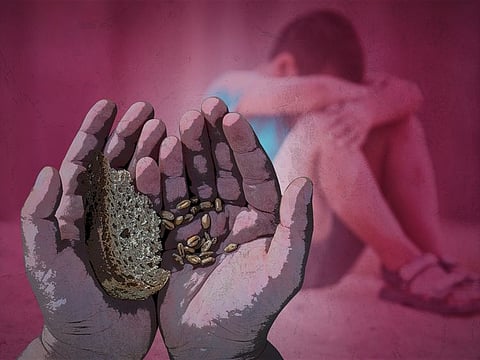Will the world answer Syrian children’s call for help?
Situation is desperate for refugees. Those who survived the war are being killed by cold

The situation of the Syrian refugees has become so exceedingly unbearable this winter that a Palestinian refugee camp launched a campaign to raise funds to help the Syrians displaced by the war in their once flourishing country.
It has been an exceptionally harsh winter this year in many parts of the region. Severe snowstorms, unseen in decades, have ravaged several areas in Syria and Lebanon where millions of Syrian refugees had taken shelter since the Syrian war began in 2011.
More than 400,000 people have been killed in 10 years of conflict. The United Nations estimate that more than half of the country’s 22 million population fled their homes — more than 5.7 million people, half of whom are children, have made it to neighbouring countries while 6.1 million people are displaced internally within Syria.
Children have had the biggest share of misery in this endless conflict. The UN’s children relief agency, Unicef, says at least 2.6 million children remain displaced inside the country and 2.5 million children living as refugees in neighbouring countries.
Most of the refugees are in Lebanon, Jordan, and Turkey. The economic situation in the three countries haven’t been rosy in recent years, adding another layer of hardships to the already tragic situation of the Syrian refugees. But this winter the situation, especially for the displaced families in northern Syria, has been exceptionally agonising.
Brutal winter
Brutal winter storms hit the refugee camps, mostly made up of tents and vulnerable prefabricated rooms, that house hundreds of thousands of the internally displaced families in the northern parts of Syria. More than a dozen children, including at least three babies, were frozen to death, various aid agencies reported in the past three weeks.
The shocking images of barefooted children with very little to wear as they stood by their families’ snow-covered collapsed tents in the freezing temperature failed to spur a proper global reaction (I keep thinking how the world would react had those images been of western children!). The displaced families lack almost everything — winter clothes, food and medicine and tents to replace the ones ruined by the storms.
There have been campaigns, launched in some Arab countries such as the UAE with the help of the Red Crescent. One particular campaign began a couple of weeks ago in the Palestinian occupied territories. Palestinians of course know very well how it feels to live in a tent during the harsh cold months. Generations of Palestinians suffered the same miserable fate since 1948 when tens of thousands were forcefully displaced from their towns and villages.
The campaign, called “a house instead of a tent”, was launched by Palestinian activists in different cities though social media to raise funds aimed to build houses for the Syrians displaced in their country.
One certain donation was unexpected and generous — $300,000 from the residents of the Palestinian Shufat refugee camp, outside the old city of occupied Jerusalem. On social media, the camp’s residents wrote that they remember very well how the Syrian people supported them for decades. They are united in misery, it seems.
Anyone who is familiar with the abysmal conditions in the Palestinian refugee camps would of course appreciate the significance of this heartwarming gesture. The weather is only getting worse in those areas with more storms forecasted. The world will continue to watch as more children sadly die in the freezing cold.
Anti-Syrian xenophobia
The fate of those who had managed to make it to neighbouring countries doesn’t really fare much better. Lebanon has for several years in a spiralling economic crisis that virtually wiped out the middle class. The 1.5 million Syrian refugees in Lebanon bore the brunt of this financial collapse; their mere existence in Lebanon began in recent year to spark anti-Syrian xenophobia.
Syrians are only allowed to work in certain kinds of jobs, for example, but the economic meltdown in Lebanon has heightened the competition with the Lebanese who turned against the refugees for ‘taking their jobs’. Hostility against the Syrians are increasingly rife. Beirut has thus been lobbying internationally to get the Syrians out of Lebanon amid reports that many have been forced to return to Syria.
The refugee camps in eastern Lebanon meanwhile are witnessing the same harsh winter conditions as the northern Syrian camps. More than 3 million in Turkey and the nearly 700,000 in Jordan are faced more or less with the same economic and weather hardships.
Discriminatory practices
Even those who succeeded in reaching western countries are faced with great, although different type of challenge — racism. In Sweden and Denmark, Syrian asylum seekers are faced with growing discriminatory practices, even by state agencies.
Few months ago, Copenhagen said the situation in Syria was getting better, henceforth the Danish government may force them to return to Syria despite the raging war in most of the hometowns of those refugees, the areas close to the Turkish border in particular. But for many Syrians, some of the villages they came from no longer exist, and they fear they will be displaced within their country if they go back. The rest of Europe has become closed to them too.
The situation is desperate for the refugees. Those who were lucky to survive the war are being killed by the cold. Yet little help is coming. Children are the most vulnerable in this crisis.
They have already lost years of education. Now to merely survive has become a challenge. Syrian children are in dire need of safety, shelter and basically anything to shield their fragile little bodies from the freezing temperatures. Will the world answer their call?
Sign up for the Daily Briefing
Get the latest news and updates straight to your inbox



